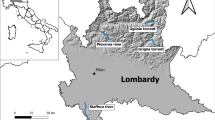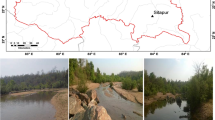Abstract
Based on data obtained from field investigations, this paper aims to analyze the influence of the river overflow on the desert riparian vegetation and discuss the function of the river overflow on the vegetation restoration at the lower Tarim River. The results show that (1) there are only 17 species, 13 genera and 9 families in the study areas before river overflow, while there are 34 species, 26 genera and 12 families after the overflowing in which 18 species emerged newly; (2) judging by the biodiversity indices, the species diversity and species richness in the river overflowed area increase more significantly than those in the un-overflow area; (3) judging by the importance of different species after years of river overflowing, the annual herbs germinate quickly at first, while the perennial herbs with deep roots or root clones become dominant in the plant community; (4) after several times of river overflowing, some arbors and shrubs such as Populus euphratica and Tamarix ramosissima germinate easily and can dominate gradually in the plant community. The results indicate that the river overflowing restores the severely degraded ecosystem in the lower Tarim River and the function is connected with restoration of eco-hydrological processes in the study areas. The results suggest that experimental overflowing has initiated a process of restoring ecosystem function within the riparian forest.




Similar content being viewed by others
References
Bailey RC (1988) Correlations between species richness and exposure freshwater molluscs and macrophytes. Hydrobiologia 162:183–191
Baskin CC, Baskin JM (1998) Seeds: ecology, biogeography and evolution of dormancy and germination. Academic Press, San Diego
Bissels S, Hölzel N, Donath TW, Otte A (2004) Evaluation of restoration success in alluvial grasslands under contrasting overflowing regimes. Biol Conserv 118:641–650
Blom CWPM, Voesenek LACJ (1996) Overflowing: the survival strategies of plants. Trends Ecol Evol 11:290–295
Capon SJ (2005) Flood variability and spatial variation in plant community composition and structure on a large arid floodplain. J Arid Environ 60:283–302
Curtis JT, McIntosh RP (1951) An upland forest continuum in the prairie-forest border region of Wisconsin. Ecology 332:476–496
Feng Q, Liu W, Su YH, Si JH, Zhang YW, Cang ZQ, Xi HY (2005) Environmental effects of water resource development and use in the Tarim River basin of northwestern China. Environ Geol 48:202–210
Gabrielie LK, Friedman JM, Beatty SW (2005) Delayed effects of flood control on a flood-dependent riparian forest. Ecol Appl 15(3):1019–1035
Huston MA (1979) A general hypothesis of species diversity. Am Nat 113:81–101
Jansson R, Zinko U, Mettitt DM (2005) Hydrochory increases riparian plant species richness: a comparison between a free-flowing and a regulated river. J Ecol 93:1094–1103
Margalef R (1968) Perspective in ecological theory. University of Chicago Press, Chicago
Menhinick EJ (1964) A comparison of some species—individual diversity indices applied to samples of field insects. Ecology 45:859–861
Pielou EC (1975) Ecological diversity. Wiley, New York
Pollock MM, Naiman RJ, Hanley TA (1998) Plant species richness in riparian wetlands—a test of biodiversity theory. Ecology 79:94–105
Setter TL, Ellis M, Laureles EV, Ella ES, Senadhira D, Mishra SB, Sarkarung S, Datta S (1997) Physiology and genetics of submergence tolerance in rice. Ann Bot 79:67–77
Shannon CE, Wiener W (1949) The mathematical theory of communication. University of Illinois Press, Urbana, pp 19–107
Simpson EH (1949) Measurement of diversity. Nature 163:668
Stromberg JC (2001) Restoration of riparian vegetation in the south-western United States: importance of flow regimes and fluvial dynamism. J Arid Environ 49:17–34
Tilman D (1983) Plant succession and Gopher disturbance along an experimental gradient. Oecologia 60:285–292
Umar A, Umar R, Ahmad MS (2001) Hydrogeological and hydrochemical framework of regional aquifer system in Kali-Ganga sub-basin, India. Environ Geol 40(5):602–611
Wuetrich B (1996) Deliberate flood renews habitats. Science 272:344–345
Zhang JT (2004) Quantitative ecology. Science Press, Beijing, pp 87–91
Acknowledgments
The research was supported by a grant under the National Natural Science Foundation of China (Nos. 30600092 and 40671036). The authors’ deep appreciation is expressed for the valuable comments on the manuscript.
Author information
Authors and Affiliations
Corresponding author
Rights and permissions
About this article
Cite this article
Xu, H., Ye, M. & Li, J. The ecological characteristics of the riparian vegetation affected by river overflowing disturbance in the lower Tarim River. Environ Geol 58, 1749–1755 (2009). https://doi.org/10.1007/s00254-008-1674-5
Received:
Accepted:
Published:
Issue Date:
DOI: https://doi.org/10.1007/s00254-008-1674-5




